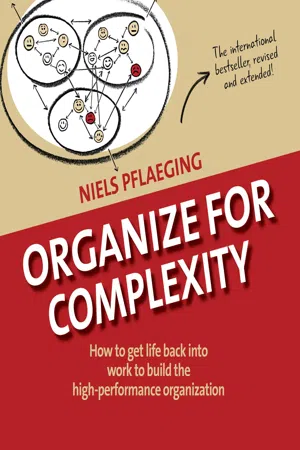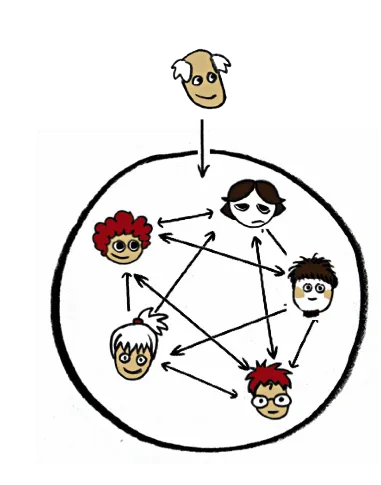
eBook - ePub
Organize for Complexity
How to Get Life Back Into Work to Build the High-Performance Organization
Niels Pflaeging, Pia Steinmann
This is a test
- English
- ePUB (apto para móviles)
- Disponible en iOS y Android
eBook - ePub
Organize for Complexity
How to Get Life Back Into Work to Build the High-Performance Organization
Niels Pflaeging, Pia Steinmann
Detalles del libro
Vista previa del libro
Índice
Citas
Información del libro
The long-awaited update for work and organizations in the knowledge age!
A book about complexity and work - and about how to deal productively with both.
A condensed introduction to the theory and practice of organizational high performance.
A manifesto for contemporary leadership and profound transformation in organizations of all kinds.
Preguntas frecuentes
¿Cómo cancelo mi suscripción?
¿Cómo descargo los libros?
Por el momento, todos nuestros libros ePub adaptables a dispositivos móviles se pueden descargar a través de la aplicación. La mayor parte de nuestros PDF también se puede descargar y ya estamos trabajando para que el resto también sea descargable. Obtén más información aquí.
¿En qué se diferencian los planes de precios?
Ambos planes te permiten acceder por completo a la biblioteca y a todas las funciones de Perlego. Las únicas diferencias son el precio y el período de suscripción: con el plan anual ahorrarás en torno a un 30 % en comparación con 12 meses de un plan mensual.
¿Qué es Perlego?
Somos un servicio de suscripción de libros de texto en línea que te permite acceder a toda una biblioteca en línea por menos de lo que cuesta un libro al mes. Con más de un millón de libros sobre más de 1000 categorías, ¡tenemos todo lo que necesitas! Obtén más información aquí.
¿Perlego ofrece la función de texto a voz?
Busca el símbolo de lectura en voz alta en tu próximo libro para ver si puedes escucharlo. La herramienta de lectura en voz alta lee el texto en voz alta por ti, resaltando el texto a medida que se lee. Puedes pausarla, acelerarla y ralentizarla. Obtén más información aquí.
¿Es Organize for Complexity un PDF/ePUB en línea?
Sí, puedes acceder a Organize for Complexity de Niels Pflaeging, Pia Steinmann en formato PDF o ePUB, así como a otros libros populares de Business y Management. Tenemos más de un millón de libros disponibles en nuestro catálogo para que explores.
Información
Part 1. Complexity: Why it matters to work and organizations (Big time.)
Management, the social technology: Rise and fall of a brilliant idea
In 1911, Frederick W. Taylor published his landmark book “The Principles of Scientific Management.” He proposed his new brand of organizational science as nothing short of a “revolution” that would eliminate the productivity constraints of the industrial-age organization. Taylorism indeed achieved just that. Taylor became the founder of management as an organizational method that would give wings to the quest for efficiency of the industrial age.
What Taylor pioneered was the idea of consistently dividing an organization between thinking people (managers) and executing people (workers) – thus legitimating the management profession as that of thinking principals of the non-thinking human resources. Taylor also introduced functional division to shop-floor work. His concepts were soon decried as inhumane and non-scientific, his consulting methods as ineffective. But Taylor was a visionary with the dream of pacifying workers and managers through efficiency gains that would benefit all.

The division principle became the DNA of management, the social technology: hierarchical and functional division were widely adopted after Taylor´s death in 1915, and to great effect. His principles were later applied to non-industrial, non-shop-floor work – all kinds of work, in fact. Management, as we know it today, is not much different from what Taylor proposed a century ago. As we will see, however, command-and-control has turned toxic for both organizational performance and human/social advancement.
We call tayloristic management Alpha.
The price of simplicity: Three systemic gaps caused by management
First: The Social Gap
Hierarchical division and top-down control cause an erosion of social/group pressure and dialog, and a bias towards management by numbers and leadership by fear

Second: The Functional Gap
Functional division leads to narrow and fragmented responsibilities. It produces a need for managed/imposed coordination through process control, interfaces, planning, rules, standards, hierarchic power etc.

Third: The Time Gap
The division between thinking thinkers and non-thinking doers, between planning and execution, results in the need for managed/imposed roles, complicated IT, strategy, targets, forecasting, and planning

None of this feels good. None of this creates value for people, customers, or owners: the three gaps all lead to waste. That´s a high price for the illusion of control.
The historical course of market dynamics and the recent rise of complex, global markets
We call the graph shown below the “Taylor Bathtub.”
The industrial age brought with it a brief period of fast-growing, spacious mass markets with relatively little competition. Monopolies or oligopolies dominated, markets were dull, or sluggish. During that period, Alpha became the standard organizational model: because it was possible, for the first time in human history, to largely eliminate complexity from value-creation with the help of machines and standards. For this task Taylorism, or Alpha, was the perfect solution.
Those days are gone. High-dynamic value creation re-emerged around the 1970s, due to the rise of global, high-competition markets and the return of more individualized demand that made customization paramount and enabled “mass-customization.”

High-dynamic value creation, in turn, calls for an increase in the human part of problem-solving processes. Alpha has become a roadblock.
The dominance of high dynamics and complexity is neither good, nor bad. It‘s a historical fact.
* The terms dynamics and complexity will be used synonymously throughout this book, most of the time – for the sake of simplicity.
The difference between the complicated and the complex
Complicated systems operate in standardized ways. In complicated systems imprecision is diminished and non-objectivity and uncertainty are reduced as far as possible. Such a system can be described through non-ambiguous cause-and-effect chains. It is externally controllable.

Any high-precision machine is complicated: everything is done to avoid imprecision/to increase precision. A watch, for example, is calibrated to diminish mistakes and uncertainty. It is configured to supply objective data, certainty and a minimum of illusion.
Complex systems produce surprises. They have presence or participation of living creatures. They are living systems – that’s why they may change at any moment. Such systems are only externally observable – not controllable.

A complex systems’ behavior is non-predictable. In a complex system, it’s natural that there is a level of error, uncertainty and illusion that is much higher than in complicated systems. A complex system may possess elements that can operate in standardized ways, but their interaction would be constantly changing, in discontinuous ways.
To treat complex organizations as complicated systems is a fundamental thinking mistake, an over-simplification.
Consequences of complexity: The importance of mastery for problem-solving today
The only “thing” capable of dealing effectively with complexity is human beings.
What matt...
Índice
Estilos de citas para Organize for Complexity
APA 6 Citation
Pflaeging, N., & Steinmann, P. (2014). Organize for Complexity (5th ed.). nielspflaeging. Retrieved from https://www.perlego.com/book/2856140/organize-for-complexity-how-to-get-life-back-into-work-to-build-the-highperformance-organization-pdf (Original work published 2014)
Chicago Citation
Pflaeging, Niels, and Pia Steinmann. (2014) 2014. Organize for Complexity. 5th ed. nielspflaeging. https://www.perlego.com/book/2856140/organize-for-complexity-how-to-get-life-back-into-work-to-build-the-highperformance-organization-pdf.
Harvard Citation
Pflaeging, N. and Steinmann, P. (2014) Organize for Complexity. 5th edn. nielspflaeging. Available at: https://www.perlego.com/book/2856140/organize-for-complexity-how-to-get-life-back-into-work-to-build-the-highperformance-organization-pdf (Accessed: 15 October 2022).
MLA 7 Citation
Pflaeging, Niels, and Pia Steinmann. Organize for Complexity. 5th ed. nielspflaeging., 2014. Web. 15 Oct. 2022.